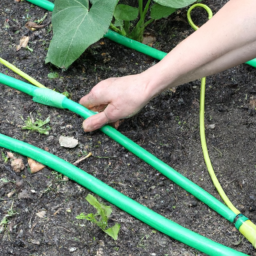How To Use A Soaker Hose in a Vegetable Garden
How To Use A Soaker Hose In A Vegetable Garden
Utilizing a Soaker Hose in Your Vegetable Garden
Soaker hoses are an economical and efficient way to water the vegetable plants in your garden. Read on to learn the different ways you can use a soaker hose and for all the tips and tricks to make the most of this unique watering system.
Background of Soaker Hoses
Soaker hoses are perforated tubes that slowly release water. A soaker hose is usually made of recycled rubber or vinyl and contains tiny holes that slowly release the water over a large area. Soaker hoses have been around since the 1930s and are gaining in popularity again today because of the easy, low-cost way to water plants.
How Do Soaker Hoses Work?
Soaker hoses transfer water to the roots of plants, rather than just the surface of the soil. The low-pressure delivery of water creates less wastage and pushes water further into the soil, which encourages deeper roots. Additionally, soaking the soil can also help reduce the spread of weeds, while also making the most of fertilizers.
Water flows to the highest point of the hose. Therefore, when you are setting up your soaker hose, it is important to have the hose at a lower level than the plants you are watering. You should also install the soaker hose near to the base of your plants to get the best results.
Advantages of Soaker Hoses
Soaker hoses have numerous advantages over traditional watering methods. Some of the main benefits are:
- They provide a more consistent water delivery system than sprinklers that are prone to uneven water application or blow away in windy conditions.
- They can water plants for a longer period without needing any improvements; the water is spread over an extended period rather than all at once.
- Save more water than normal irrigation systems. Soaker hoses have up to 70% less water wastage then the traditional methods such as garden sprinklers.
- Soaker hoses are incredibly easy to install and require very little in terms of setup or maintenance.
Safety considerations
When using soaker hoses, there are some safety considerations to keep in mind. The high water pressure from the hose can damage your plants if it is too high. You should always use the lowest water pressure setting on your soaker hose, and never run the hose unattended. Additionally, bury the soaker hose about 6-8 inches below the surface to protect it from the sun and other elements that can cause the hose to wear down prematurely.
Applications
Soaker hoses are most often used for vegetable gardens, but they can also be used for flower beds, hedges, and other large landscaping projects. They are best used when the plants are planted at ground level, rather than against retaining walls or in containers. Additionally, soaker hoses can help keep weeds at bay, as excess water will not create ideal conditions for them.
Potential Challenges
Although soaker hoses are an efficient and cost-effective way to water your plants, there are potential challenges to consider. They are not as effective in sloped areas or areas with clay soil, as water can run off the slopes or become trapped in the clay. In addition, the holes can become blocked by debris over time, so it is important to regularly check the hose for blockages.
Final Word
Soaker hoses are a great way to water your vegetable garden while conserving water and keeping your plants healthy. It is important to consider the pros and cons of soaker hoses when selecting a watering system and to always follow the safety considerations for a successful installation. With a little bit of preparation and regular maintenance, you can have a garden that is healthy, lush, and free of weeds.

Previous Page
Next Page
